当前位置:
X-MOL 学术
›
Environ. Sci. Technol. Lett.
›
论文详情
Our official English website, www.x-mol.net, welcomes your feedback! (Note: you will need to create a separate account there.)
The Wax–Liquid Transition Modulates Hydrocarbon Respiration Rates in Alcanivorax borkumensis SK2
Environmental Science & Technology Letters ( IF 10.9 ) Pub Date : 2018-04-23 , DOI: 10.1021/acs.estlett.8b00143 Li-Na Lyu 1, 2, 3, 4 , Haibing Ding 1, 5 , Zhisong Cui 2, 3, 6 , David L. Valentine 2, 3
Environmental Science & Technology Letters ( IF 10.9 ) Pub Date : 2018-04-23 , DOI: 10.1021/acs.estlett.8b00143 Li-Na Lyu 1, 2, 3, 4 , Haibing Ding 1, 5 , Zhisong Cui 2, 3, 6 , David L. Valentine 2, 3
Affiliation

|
Marine hydrocarbon biodegradation is an important environmental process conducted by microbes and modulated by oceanographic conditions. Following up on the patterns of petroleum hydrocarbon biodegradation observed after the Deepwater Horizon disaster, we measured respiration rates for the obligate alkane-degrading bacterium, Alcanivorax borkumensis SK2, to assess the relationship between hydrocarbon respiration rates and the phase, wax versus liquid, of the substrate. Using a matrix of temperatures (20, 25, 30, 35, and 40 °C) and n-alkanes (n-C14, n-C15, n-C16, n-C17, n-C18, n-C19, and n-C20) for which each temperature gap spans the phase transition point of an n-alkane, we demonstrate that the n-alkane respiration rate decreases substantially when the substrate is in the wax versus liquid phase. The observed effect spans the full experimental temperature range. Subsequent experimentation with only wax-phase n-C19 indicates that the availability of surface area modulates the n-alkane respiration rate and is likely a factor contributing to the observed respiration rates being lower for wax-phase than for liquid-phase hydrocarbons. These results demonstrate that wax-phase hydrocarbons are subject to biodegradation by A. borkumensis SK2 but that rates are suppressed relative to those of liquid-phase hydrocarbons. The results are consistent with interpretations of hydrocarbon biodegradation patterns from Deepwater Horizon with broader relevance to the behavior of hydrocarbons in the ocean.
中文翻译:

蜡液过渡过程调节了褐藻藻SK2中的碳氢化合物呼吸速率。
海洋碳氢化合物的生物降解是微生物进行的重要环境过程,受海洋条件的影响。遵循“深水地平线”灾难后观察到的石油碳氢化合物生物降解模式,我们测量了专性烷烃降解细菌Alcanivorax borkumensis SK2的呼吸速率,以评估碳氢化合物呼吸速率与烃的相,蜡与液体之间的关系。基质。使用温度(20、25、30、35和40°C)和正构烷烃(n -C 14,n -C 15,n -C 16,n -C 17的矩阵),n -C 18,n -C 19和n -C 20)(每个温度间隔都跨越正构烷烃的相变点),我们证明了当基质位于正构烷烃中时,正构烷烃的呼吸速率显着降低。蜡与液相的关系。观察到的效果跨越了整个实验温度范围。随后仅用蜡相n -C 19进行的实验表明,表面积的可利用性调节了n-烷烃的呼吸速率,并且可能是导致蜡相观察到的呼吸速率低于液相烃的观察到的呼吸速率的因素。这些结果表明,蜡相烃被A. borkumensis SK2进行生物降解,但相对于液相烃而言,其速率受到抑制。结果与“深水地平线”对烃类生物降解模式的解释一致,与海洋中的烃类行为具有更广泛的相关性。
更新日期:2018-04-24
中文翻译:

蜡液过渡过程调节了褐藻藻SK2中的碳氢化合物呼吸速率。
海洋碳氢化合物的生物降解是微生物进行的重要环境过程,受海洋条件的影响。遵循“深水地平线”灾难后观察到的石油碳氢化合物生物降解模式,我们测量了专性烷烃降解细菌Alcanivorax borkumensis SK2的呼吸速率,以评估碳氢化合物呼吸速率与烃的相,蜡与液体之间的关系。基质。使用温度(20、25、30、35和40°C)和正构烷烃(n -C 14,n -C 15,n -C 16,n -C 17的矩阵),n -C 18,n -C 19和n -C 20)(每个温度间隔都跨越正构烷烃的相变点),我们证明了当基质位于正构烷烃中时,正构烷烃的呼吸速率显着降低。蜡与液相的关系。观察到的效果跨越了整个实验温度范围。随后仅用蜡相n -C 19进行的实验表明,表面积的可利用性调节了n-烷烃的呼吸速率,并且可能是导致蜡相观察到的呼吸速率低于液相烃的观察到的呼吸速率的因素。这些结果表明,蜡相烃被A. borkumensis SK2进行生物降解,但相对于液相烃而言,其速率受到抑制。结果与“深水地平线”对烃类生物降解模式的解释一致,与海洋中的烃类行为具有更广泛的相关性。


























 京公网安备 11010802027423号
京公网安备 11010802027423号